Decoupage for beginners from napkins: choice of materials and a step-by-step guide
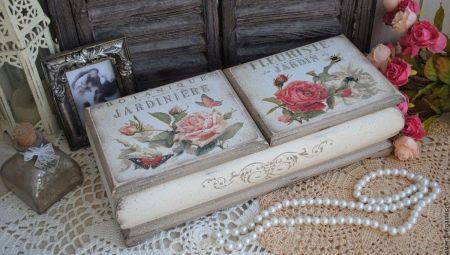
The desire to create something extraordinary with their own hands periodically arises in many representatives of the beautiful half of humanity. But what if there are no skills in classical drawing, painting, sculpture? It takes a long time to study, but you want to create beautiful handmade items, please yourself and your loved ones right now. An easy-to-learn decoupage technique can be the perfect solution.
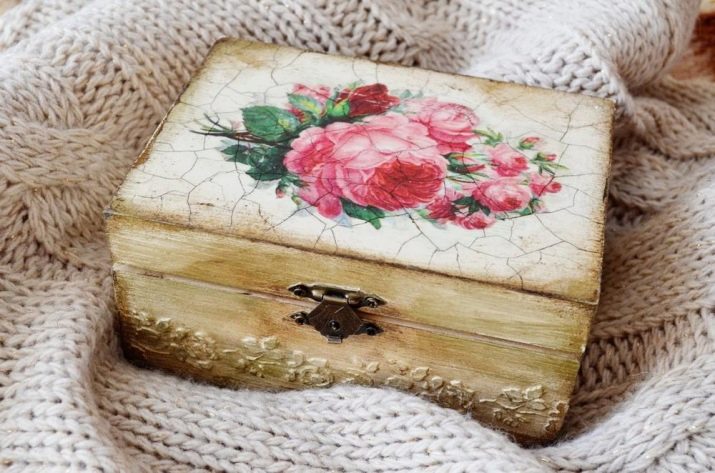
Features of technology.
The word "decoupage" comes from the French decuoper, which means "cut, cut".
The main idea of decoupage is to decorate an item with carved drawings. The goal is to create an imitation of a drawn image on a product. The technique includes three simple steps:
- cutting out a drawing, picture, ornament;
- overlaying and attaching them to an object;
- coating the composition with varnish for strength and durability.

What can be decoupage? Absolutely any thing from any material. Depends on the flight of imagination and material possibilities.
Candles, boxes, dishes, clocks, hangers, flower pots, watering cans, photo frames, boxes, pieces of furniture, doors, various decor items are most often the object of creativity in this technique.
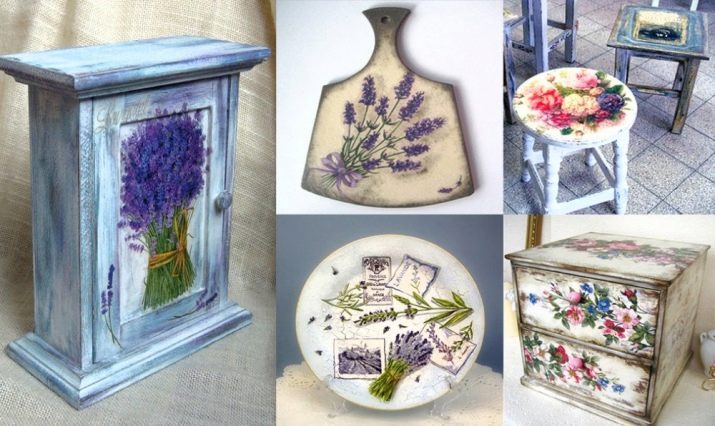
Decoupage has great potential.
With minimal cost, many things can get a second life, and simple objects can turn into real masterpieces of fine art.
There is an opportunity to transform the interior with your own hands, to make a luxurious gift for any occasion.
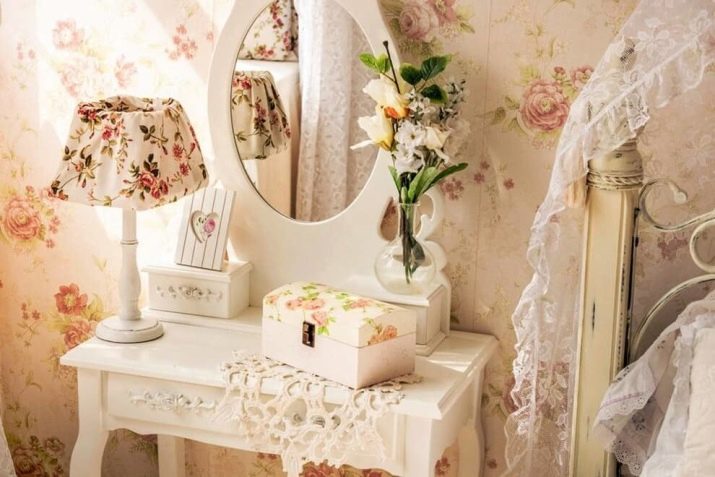
Mastering new skills will allow you to find a fascinating hobby that develops creativity and a sense of beauty, to give you the opportunity to feel like an artist, a creator.
With the development of skills to professional and a certain courage, a hobby can develop into a favorite business that brings additional income.
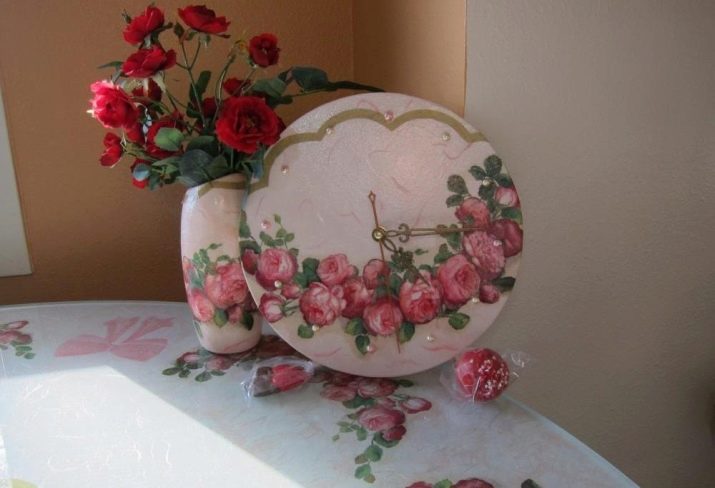
What do you need?
For the first trials in this kind of applied art, it is enough to have a napkin with a beautiful image, the surface to be transformed, sharp scissors, brushes, glue and varnish.
In the process of mastering the skills, the list will expand and deepen, your favorite materials and techniques will appear.
The basis for decoupage. Items are perfect for the product:
- made of wood;
- plywood;
- plastic;
- glass;
- cardboard;
- gland;
- porcelain;
- fabrics.

The easiest decoupage can be done on an ordinary wax candle. Textiles are material for advanced craftsmen.
Both old things that were in everyday life and special blanks for decoupage are decorated.
Depending on the degree of processing and surface structure, the need for additional materials, work and the amount of time spent is determined.

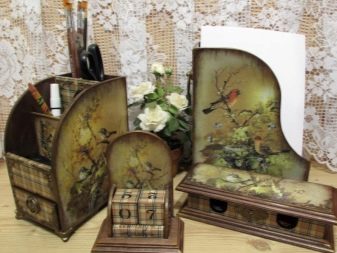
Napkins
In decoupage, special napkins are used that have a colorful pattern, special material and texture. Ordinary serving napkins may not work. Some because of the poor quality of the paper, others because of the high.
Decoupage napkins vary in size and shape. The largest are square 40x40 cm, rectangular 33x42, round with a diameter of 32 cm.
The size and configuration are selected based on the area of the surface to be coated.
You can find the following in art stores.
- Decoupage napkins with from one to four layers. The most popular are three-layer. The bottom two layers are not used. The layer that is applied to the surface is very thin and capricious. It can crumple, stretch and tear at the most crucial moment. For beginners, this task can be challenging without a well-honed skill.
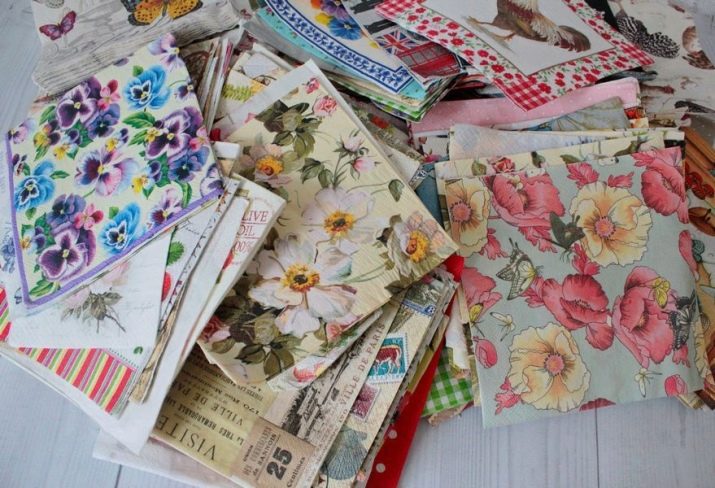
- Decoupage cards on rice paper. The special base makes this material more elastic and obedient and does not allow deformation under the influence of liquids.
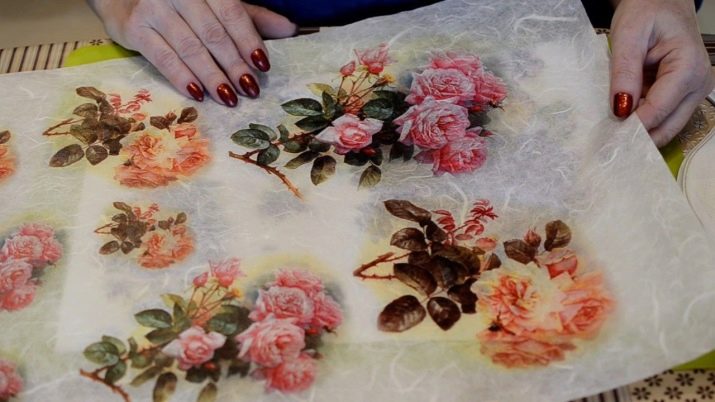
- Decoupage cards on paper. Good for use on flat, smooth surfaces.

Instruments
An extremely simple set.
The decoupage master will need:
- thin sharp scissors, which will be convenient to cut images;
- flat synthetic brushes with a tightly fixed pile and a size that is comfortable for processing a specific surface;
- small rollers several centimeters wide, convenient for applying varnish;
- art brushes for drawing details;
- sandpaper (if necessary, sanding a wooden surface).

Priming
Necessary to reduce the absorbency of wood or discoloration of the surface. Usually taken in white, put in several layers.
It is selected according to the type of material.
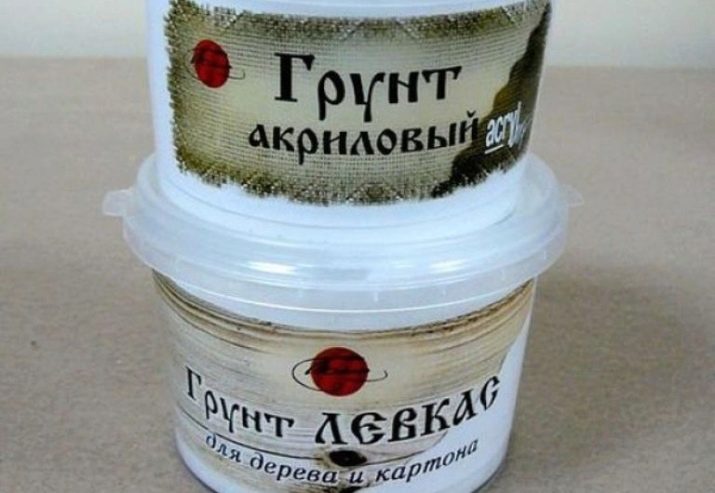
Glue
The main criteria for the glue: uniform consistency, neutral odor, transparent result at the exit. You can use such varieties.
- Special glue for decoupage. Besides its main purpose, it imparts gloss and shine. The dishes decorated with it can be used for their intended purpose. Its disadvantage is its high price compared to other materials.
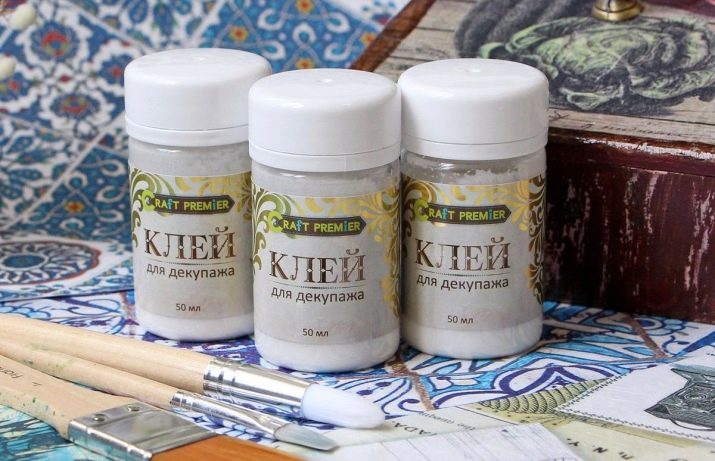
- PVA glue Is the most popular choice. The quality is not inferior to the special one, and the cost is much more affordable.
Better to use construction.
It can be used in its usual form or diluted in a ratio of 2: 1 or 1: 1. Experientially, each master determines for himself which composition is easier for him to work with.
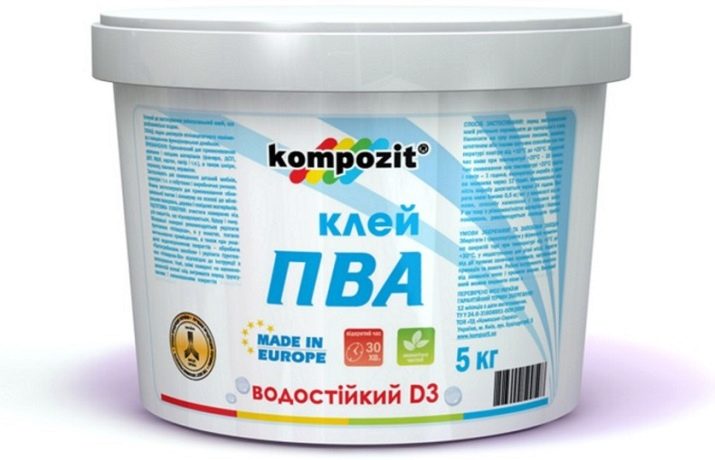
- Varnish... The disadvantage of such image attachment is the irreversible result after drying. While the defects can be eliminated when working with glue, this is not possible in the case of varnish.
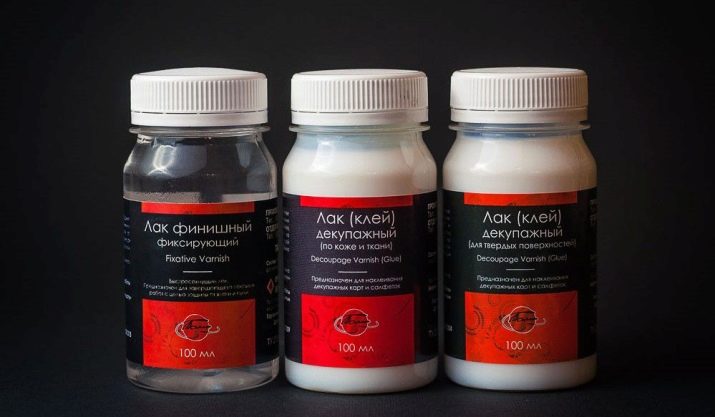
- Glue stick. Only suitable for perfectly smooth surfaces.

- Homemade glue... Acceptable economy option from available products. Some recipes suggest using starch, water and sugar, while others use egg white in combination with granulated sugar.

Fixing varnish
Acrylic water-based varnish is recognized as the best. It is less toxic and easy to use.
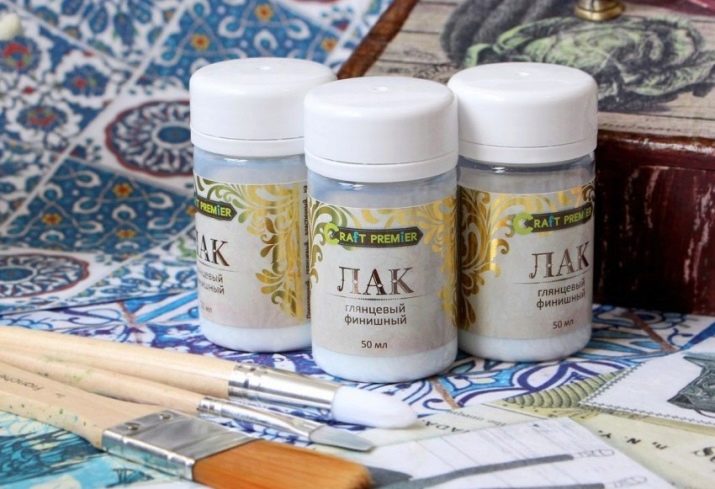
Acrylic based paints
They can be useful for drawing individual elements.

Choosing a style
The composition will look harmonious if all its details are kept in the same style. In this case, the work will take on a finished and perfect look.
Consider the features of the most popular styles in decoupage.
Provence
The trend was born in the south of France, as opposed to the classic style of bustling cities. Simple, natural, rustic, cozy, sunny, soulful - adjectives that fully characterize Provence.
The main subjects of the images: village landscapes, rural courtyard, delicate wildflowers, sprigs of lavender, sage, pets, chickens, roosters, owls, kitchen utensils, still lifes, gifts of nature.
The colors used are delicate, pastel, natural: bluish gray, white, lilac.
Gifts and home decorations decorated in this style will add a feeling of warmth, care and simplicity.
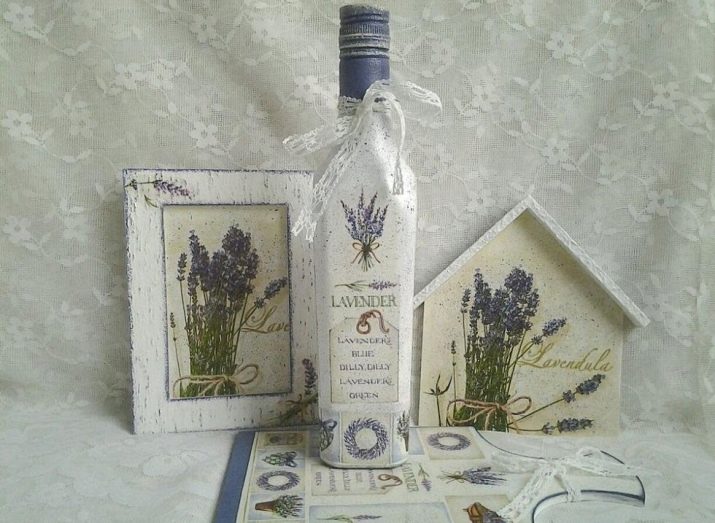
Vintage
Items in this style are designed in accordance with the once fashionable trends "antique". In appearance, they should have a respectable age and convey the atmosphere of a past era.
The main thing in vintage is the individuality of the concept, strict adherence to the displayed style of the past, unusually elegant and graceful lines and curves. Plant ornaments, roses, images of animals, insects are used.
The color scheme usually serves as one color. The tones are muffled, soft, calm.
For vintage works, the creation of the effect of natural materials is characteristic, and most often they are used: wood, leather, lace, aged metal.

Shabby chic
A young and popular decorative style. Born in the late 80s of the last century in the UK. Literally translated - "shabby chic". Combines elements of Provence, vintage and Rococo. Things in this style look maintained, faded, defective and at the same time of high quality and sturdy, giving the appearance of antiques.
Objects are painted in light pastel colors: white, ivory, pale pink, blue, and are rubbed in places. As a rule, several layers of paint are visible, as if the thing was painted more than once.
Main motives: roses, angels. Of the ornaments, only a barely noticeable cell and strip are allowed.
Shabby chic items are often used in wedding photo shoots.
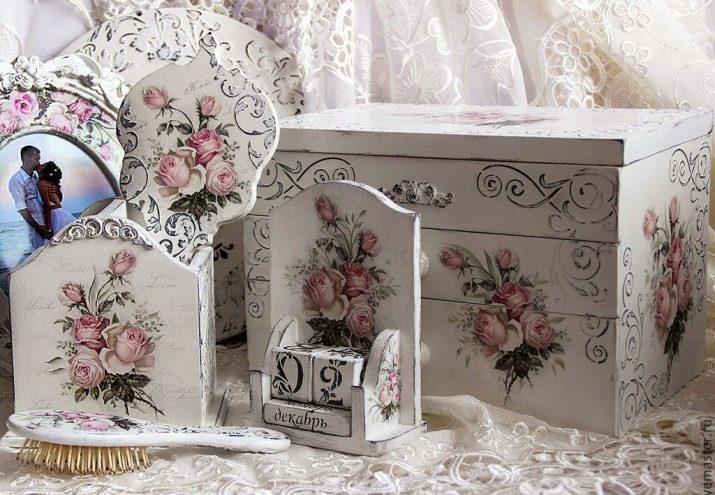
Khokhloma.
Familiar from childhood, native motives of Russian folk craft look fabulous and luxurious.
Khokhloma is characterized by the use of several juicy shades, most often red, gold, black; wonderful florid ornaments from small details, smooth lines and shapes. The main motives are vegetable: flowers, berries, peas, spikelets, stems give the state of a clear fresh autumn day.
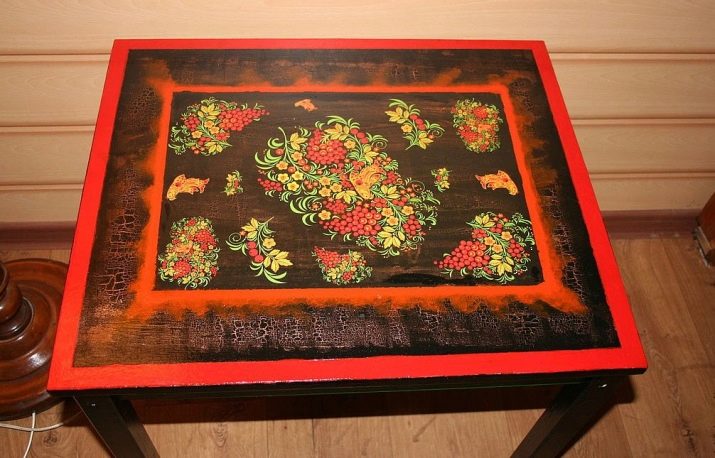
Gzhel
An incredible, snow-white Gzhel with frosty blue patterns can turn simple glass vessels, ceramic dishes into elegant porcelain.
It cannot be confused with anything. Colors: from white to dark blue. Among the motives: simple pictures, landscapes, floral ornaments, birds.
Gzhel and Khokhloma are ideal for decorating picturesque Easter and Christmas compositions for yourself and as a gift.
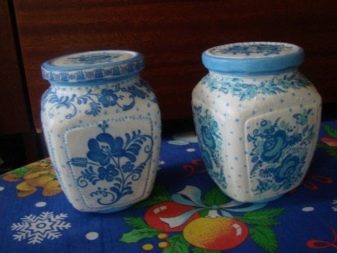
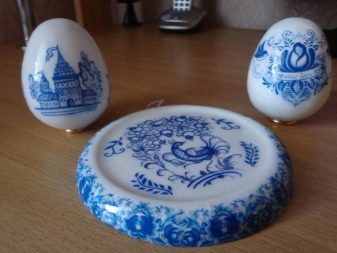
It is not at all necessary to stick to a certain style. You can find or create your own decoupage motive.
The ideal work looks like this: the image fits in size, color scheme, harmonizes with the background, does not have unnecessary details.
Step-by-step instructions for implementation
Having conceived the image, having decided on the style and choosing the necessary materials, you can start practical work.
Step by step, the decoupage process looks like this:
- sanding;
- degreasing (for glass and metal);
- padding;
- attaching a picture;
- background drawing and painting;
- varnishing;
- sanding;
- final varnish coating.
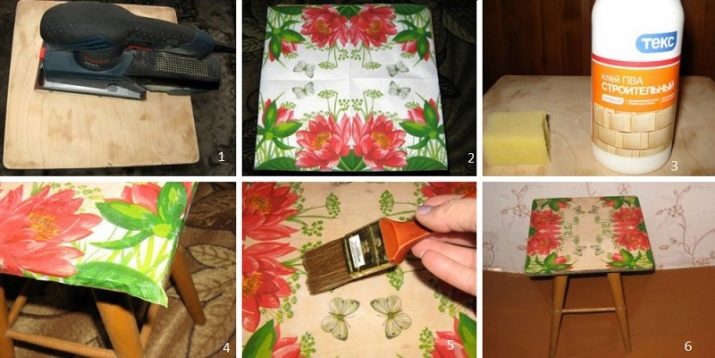
Coating with primer is one of the most important stages, with the help of which it is possible to change the color and relief of the surface. The goal is to achieve a monochromatic smooth surface. Only a perfectly smooth, light-colored wood product can avoid this procedure. Apply the primer correctly, slowly, in several thin layers.
It is worth starting to cover the next layer when the previous one has already dried. This rule also applies to the application of paints and varnishes.
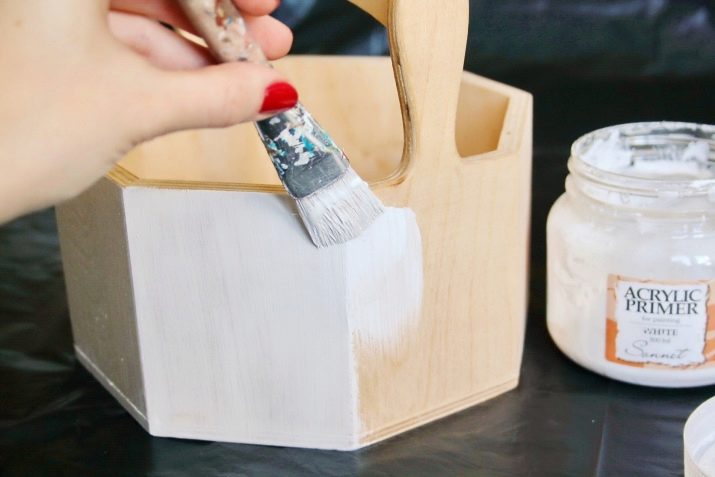
Glueing a paper napkin is the most responsible and painstaking action in the decoupage process. Let's talk in detail about the method of gluing using a clerical file, which is loved by many craftswomen for its simplicity, convenience and minimal risk of tearing the napkin.
- Place the napkin fragment with the extra layers removed "face down" on the file.
- Pour water on a napkin and waitwhen completely wet, gently smoothing the curled edges with a brush. You don't need to spare the water. The napkin should float in a puddle. When wet, it will stick to the file.
- We drain the water. We apply the image on the file to the surface, smooth it out and expel the bubbles. We carefully tear off the file. If the napkin is trailing behind, press it together with the file to the surface with a brush and try again.
- While the napkin is wet, coat it with glue, doing this from the middle to the edges. Do this with the flat side of the brush softly and gently. Remember the fragility and subtlety of the material.
- After complete drying, we cover the product with varnish. The more coats of varnish, the better for the protection and appearance of the work.
Craftsmen apply up to 100 layers, achieving an excellent surface. At a minimum, the product needs to be coated with 5 to 8 coats.

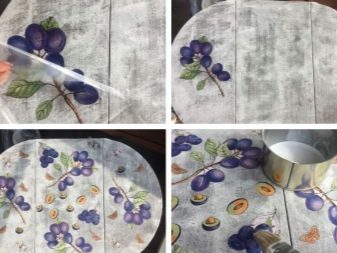
Consider the features of working with some materials
On plywood
Plywood is one of the most convenient decoupage bases. It has a smooth, even surface. It is important that it is not varnished or impregnated. You can buy ready-made plywood blanks, or you can make it yourself at home. The material is inexpensive, the price depends on the quality of the variety.
Basic actions:
- putty (in the presence of chips, cracks);
- sanding surface with fine-grained sandpaper along the fibers (with an uneven surface);
- apply a primer in several layers, while each layer is dried and sanded, let it dry;
- glue the picture according to the method described above, neatly, without folds;
- along the edges of the composition with acrylic paints we perform the background, let the composition freeze;
- cover with layers of varnish, after drying, if desired, sand it.
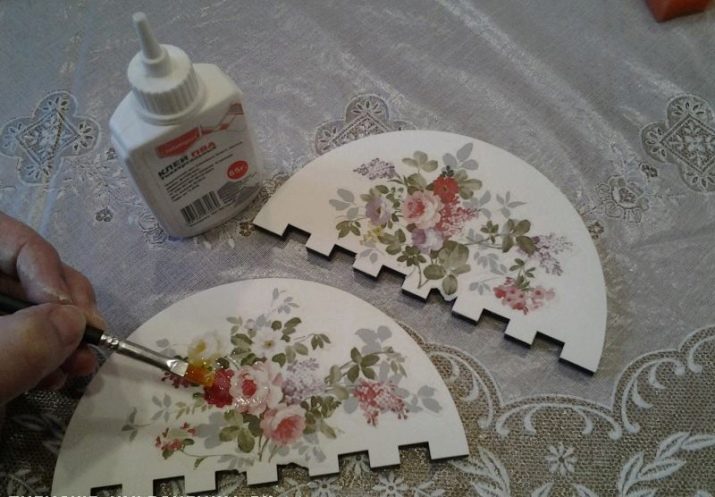
The simplest plywood product made using this technology can be a cutting board or crafts in the form of a Christmas tree toy. With the help of this technique, countertops, dressers, cabinets will heal with a new life.
If you want to give the surface an aged shabby look, you can use special paints - craquelures.
And for advanced craftswomen, you can offer to master the collage technique, which involves sticking images that differ significantly from the background in color and texture.
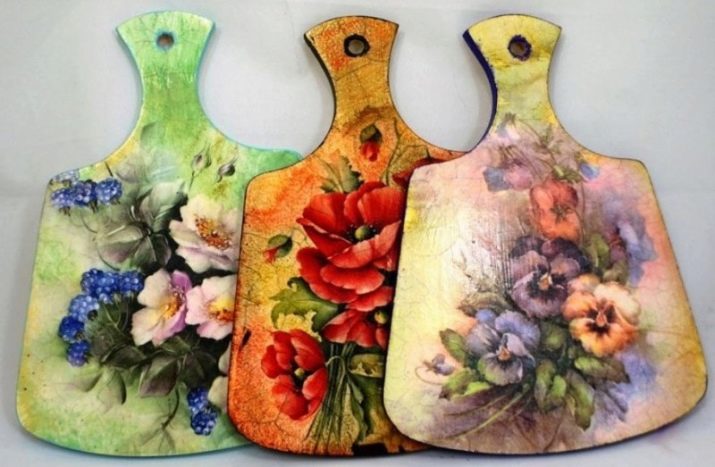
Glass work
The basis can be glass jars, bottles, vases, plates, cups, glass fragments of doors, mirrors.
It is better to work with glass with gloves so as not to leave your fingerprints on the product.
To obtain high-quality work, the glass surface is washed from dirt and degreased with alcohol, acetone or special means. You can lightly sandpaper to form small scratches, which will increase the adhesion of the soil to the surface. The rest of the technology does not differ from the usual one.
Various master classes can be found on the Internet. For example, how to turn an ordinary bottle of your favorite wine into an impressive luxurious gift that will decorate a feast and will serve as a decor item for many years, recalling happy moments.

With other surfaces
Work on metal is interesting. Lingering cans, watering cans and other gizmos, even heating batteries can be transformed using decoupage.
When working with metal, the following features are taken into account:
- rust must be removed, otherwise, the drawing will begin to flake off;
- the surface is sanded and degreased;
- a special agent is more suitable as a primer with a gypsum base or water-based paint - acrylic is not used in this case;
- if the object is supposed to be heated, then heat-resistant paints and varnishes should be used.

What can replace the napkins?
In the process of mastering the technique, you may encounter the problem that the finished image on the napkin does not fit:
- to size: the surface area exceeds the size of the largest wipes;
- by color scheme;
- according to the intended image and style.
Purchased napkins may contain unnecessary inscriptions, fragments that are problematic to remove.
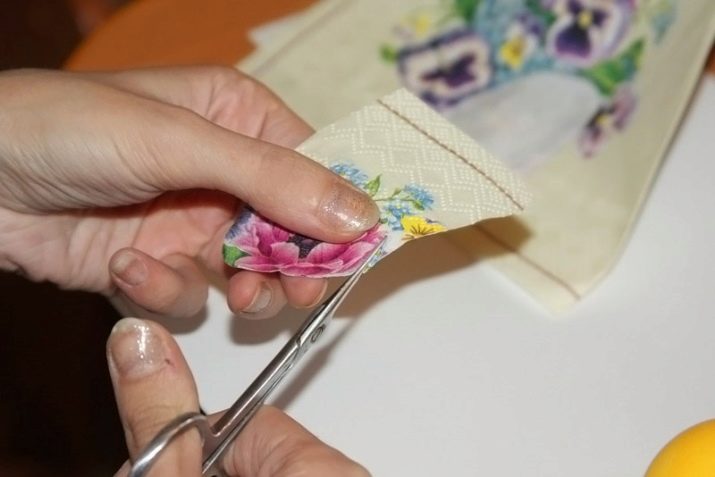
Decoupage napkins made using a special technology can be replaced by:
- printed drawings, photographs, processed in a graphics editor;
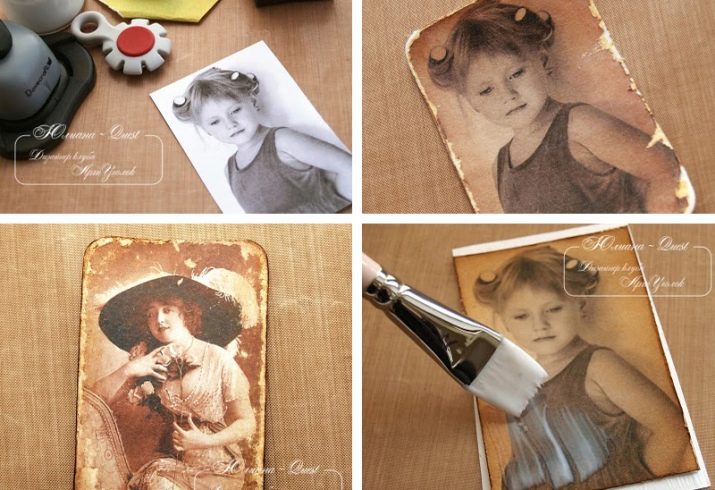
- Images from wrapping paper, magazine clippings, postcards, newspapers;

- wallpaper;
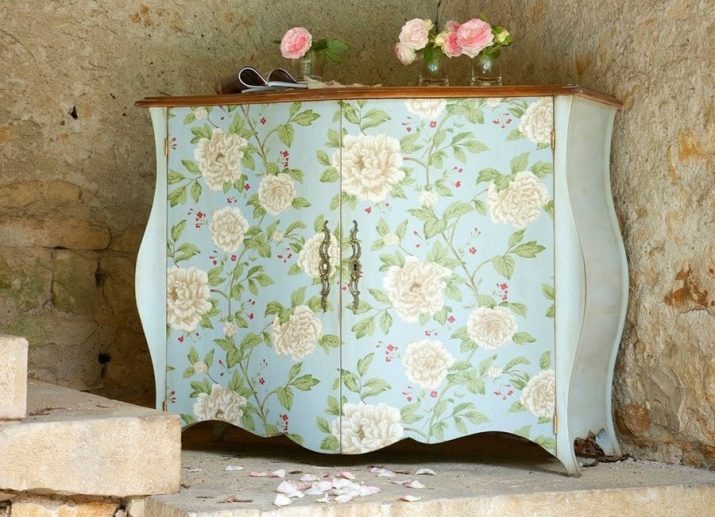
- thin cloth.

You can get acquainted with the features of decoupage Easter eggs with napkins in the next video.








